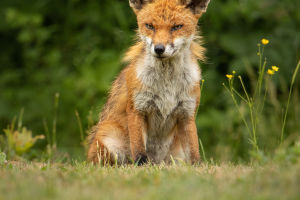Bee-eaters are fascinating birds that belong to the family Meropidae.
They are known for their striking appearance, superb flying skills, and their preference for eating bees, which is why they are called bee-eaters. There are 27 species of bee-eaters found in Africa, Asia, Europe, and Australia, and they are usually found in warm regions.
One of the remarkable characteristics of bee-eaters is their superb flying skills. Their long and pointed wings and tails allow them to fly straight and fast, with a rapid flapping of their wings, sometimes accompanied by gliding.
They are highly agile and can perform impressive aerial maneuvers. This is partly due to their strong wings, which can vibrate rapidly, giving them excellent control over their position and orientation while flying through the air.
Bee-eaters feed primarily on insects, especially bees, wasps, and dragonflies, and they hunt in a variety of ways. They are excellent at preying in flight, and their beaks are relatively long and pointed like daggers, making them well-suited for catching insects.
When they spot their prey, they swoop down, catching the insects with rapid beak and wing movements. They also have a relatively common way of foraging, which is to stand on the perch to search for insects, and once they find the target, they will swoop down.
Bee-eaters are small birds that usually have gorgeous feathers. Their feathers usually show very bright colors, such as green, purple, red, etc. These colors are very important for attracting mates and warning predators.
The bee-eater's beak is similar in shape to that of a hummingbird, also long and thin, sometimes slightly curved. However, the mouth structure of bee-eaters is more suitable for preying on insects. Their mouths can be opened very wide to catch insects larger than themselves.
Bee-eaters are social birds and usually gather together to "chat." They spend most of the day flying in the air, often in groups, and they can even help their companions raise chicks. Some species live together in groups, and they have a fairly long lifespan, living for 10 years or more.
Bee-eaters play an important role in the balance of the ecosystem. They control insect populations by preying on insects, thereby preventing damage to plants and other animals caused by excessive insect populations. This makes them valuable to farmers who rely on crops for their livelihoods. Furthermore, bee-eaters are also affected by human activities.
Their habitats are usually in natural environments such as forests, jungles, and grasslands, which are constantly being exploited and destroyed by humans. Therefore, some bee-eater species are facing the danger of extinction, and effective conservation measures need to be taken to protect their living environment and population.
In some areas, bee-eaters are considered sacred animals, believed to bring good luck and happiness. Therefore, bee-eaters have a special status and significance in local cultures.
People have even built special nest boxes to attract them to their gardens, as they are admired for their striking appearance and the benefits they bring to the environment.
Bee-eaters are fascinating birds that play an important role in maintaining the balance of the ecosystem. Their superb flying skills, striking appearance, and social behavior make them an intriguing subject of study.
However, human activities are threatening their survival, and conservation efforts are necessary to protect these valuable creatures and their habitats.


